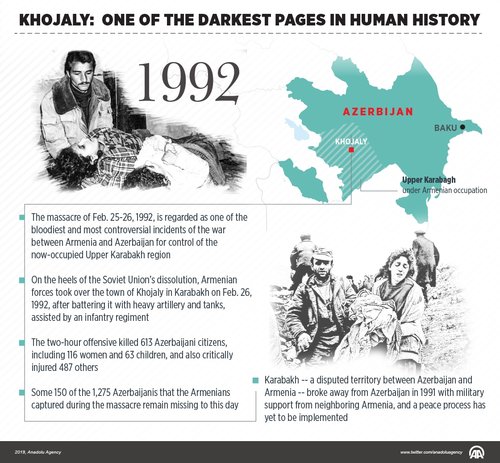An investigation into the 1992 massacre of hundreds of Azerbaijanis shed light on the horror of the incident in the town of Khojaly.
As part of a probe launched by Azerbaijan's military prosecutors, the testimonies of more than 2,000 people -- who managed to escape the massacre --, over 800 expert reports and information obtained from other sources proved that the Armenians committed mass killings, apart from occupation.

The investigation file, which lists the Armenian army officers who committed the massacre in Khojaly, also includes the names of 38 senior officers -- mostly of the Armenian origin -- from the army of then Soviet Union.
The army officers are accused of war crimes as Azerbaijanis demand the perpetrators to be tried for killing 613 civilians.
The document also tells the process paving the way for the massacre inscribed as disgrace of humanity.
Armenians took action to take over Khojaly -- the strategically important region with the only airport -- upon the collapse of the Soviet Union in 1991 and on Feb. 25, 1992 they intensified months-long attacks.
In addition to torturing the captives, the Armenians committed one of the bloodiest massacres of the 20th century, according to the investigation report.
A total of 613 vulnerable people, including 106 women, 63 children and 70 elderly people were killed in Khojaly, previously inhabited with 7,000 people.
Some 487 people, including 76 children, were critically injured, while 150 of 1,275 Azerbaijanis that the Armenians captured during the massacre still remain missing.
Eight families were completely removed out of the world, 130 children became orphan and some 25 children lost both of their parents in the massacre.
Meanwhile, the occupation costed the Azerbaijani government some $170 million.
The forensic reports on the dead bodies and the statements of witnesses clearly revealed that the Khojaly residents were subjected to extreme torture -- including burning alive, slaughtering people, peeling the scalp off, cutting the ear, nose, or sexual organs off, and removing the eyes -- regardless of gender or age.
Even pregnant women were also subjected to brutality of Armenians.
The Feb. 25-26, 1992 massacre is seen as one of the bloodiest incidents of the war between Armenia and Azerbaijan for control of the now-occupied Karabakh region.
Karabakh -- a disputed territory between Azerbaijan and Armenia -- broke away from Azerbaijan in 1991 with military support from neighboring Armenia, and a peace process has yet to be implemented.
Three UN Security Council resolutions and two UN General Assembly resolutions refer to Karabakh as being part of Azerbaijan, and the Parliamentary Assembly of the Council of Europe refers to the region as being occupied by Armenian forces.
The Armenian occupation of Karabakh led to the closing of the frontier with Turkey, which sides with Baku in the dispute.